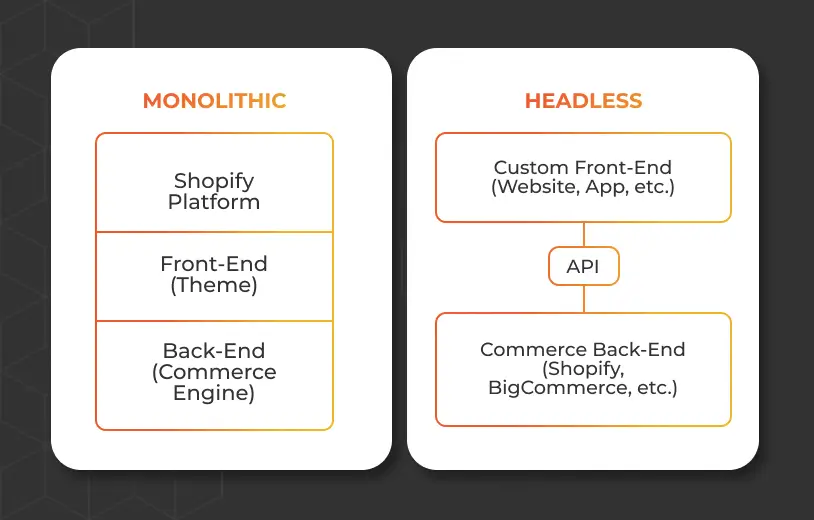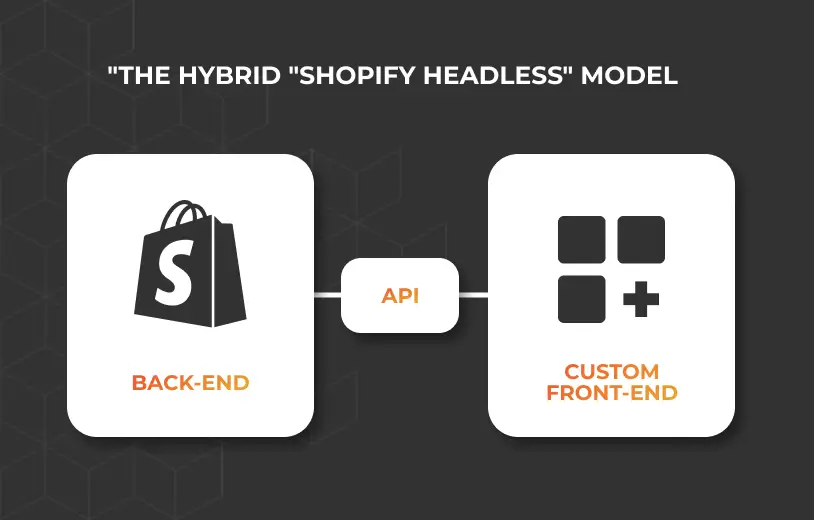Key Takeaways
- The core difference is between a monolithic platform like Shopify (where front-end and back-end are combined) and a decoupled or headless architecture (where they are separate and communicate via APIs).
- For businesses with standard e-commerce models, Shopify’s all-in-one solution offers unparalleled ease of use, a rich app ecosystem, and a lower initial technical overhead.
- For enterprises focused on a unique customer experience, superior site speed, and a true omnichannel strategy, headless provides limitless customization and future-proofs your tech stack.
- You can now use Shopify headless commerce, leveraging Shopify’s robust back-end while building a completely custom front-end. This offers a “best of both worlds” approach for many growing brands.
- The right choice depends entirely on your business goals, budget, technical resources, and long-term vision—not just on the technology itself.
In the relentless pursuit of digital dominance, enterprise e-commerce leaders eventually arrive at a critical inflection point.
Do you stick with a powerful, integrated solution like Shopify, or is it time to embrace the flexibility and raw power of a headless commerce architecture?
The platform that powered your initial growth begins to show its limitations.
Site speed becomes a daily conversation, implementing a truly unique customer experience feels like a battle against the template, and scaling your omnichannel vision seems architecturally impossible.
This decision between a traditional platform and headless e-commerce isn’t just a technical one; it’s a strategic one that will define your brand’s agility, scalability, and customer experience for the next decade.
As strategic partners to high-growth enterprises, we’ve guided countless clients through this exact decision. Here’s our framework for choosing the right path for your business.
Understanding the Contenders: Monolith vs. Decoupled

Before we compare features, it’s crucial to understand the core architectural difference.
What is Shopify? The Monolithic Powerhouse
Shopify (specifically Shopify and Shopify Plus) represents a monolithic architecture. This means the front-end (the customer-facing website or “head”) and the back-end (the commerce engine, inventory, payment processing, checkout) are tightly coupled into a single, all-in-one solution.
Who it’s for: Shopify is an undeniable force, perfect for startups, SMBs, and even many large businesses with straightforward direct-to-consumer models.
Key Advantages:
- Speed to Market: Unmatched for getting a robust, secure, and feature-rich store online quickly.
- Ease of Use: Its intuitive admin panel empowers marketing teams to manage products, promotions, and content without heavy developer reliance.
- Rich Ecosystem: A vast app marketplace allows for easy integration of new functionalities.
- Lower Initial Overhead: Predictable subscription fees and less initial custom development make budgeting simpler.
What is Headless Commerce? The Decoupled Architect
A headless commerce architecture decouples the front-end “head” from the back-end commerce platform. The back-end exists purely as a set of commerce services (pricing, inventory, customer data) that can be called upon via an API (Application Programming Interface).
This approach to headless e-commerce allows you to build any front-end experience you can imagine—a custom website, a mobile app, an in-store kiosk, a smart mirror—and power it all with the same back-end.
Who it’s for: Enterprise-level brands, companies with a strong omnichannel focus, and businesses that view a unique digital experience as their primary competitive advantage.
Key Advantages:
- Unparalleled Flexibility: With headless commerce, your developers are free to use any front-end framework (like React, Vue, or Angular) to build a completely custom, lightning-fast user experience.
- Superior Performance: Front-ends can be hyper-optimized for speed, directly impacting Core Web Vitals, SEO rankings, and conversion rates.
- True Omnichannel: Seamlessly deliver consistent commerce experiences across your website, native mobile apps, and any future digital touchpoint.
- Future-Proofing: Your tech stack is modular. You can swap out components without a complete rebuild, a key benefit of a headless e-commerce strategy.
Head-to-Head Comparison: A Strategic Breakdown

To make an informed decision, let’s break down how these two architectures stack up on the factors that matter most to an enterprise brand.
Customization and User Experience (UX)
While Shopify offers a high degree of customization through its themes and apps, you are ultimately working within the platform’s constraints.
A headless e-commerce architecture, by contrast, offers virtually limitless freedom. Your developers can build a completely bespoke front-end, creating an inimitable digital experience that becomes a core competitive advantage.
For this reason, if your brand’s value is deeply tied to a unique UX, headless is the superior path.
Performance and Speed
In e-commerce, speed is revenue. Shopify sites can be fast, but performance can degrade with the addition of third-party apps and heavy theme customizations. Headless architecture excels here.
Because the front-end is separate, it can be built from the ground up for raw speed using modern frameworks, resulting in near-instant load times that directly boost Core Web Vitals and conversion rates. For enterprise brands where a 100ms delay can cost millions, this control is non-negotiable.
Total Cost of Ownership (TCO)
Shopify’s monolithic approach comes with predictable monthly subscription and app fees. A headless e-commerce solution has a significantly higher initial development cost and requires ongoing maintenance and hosting for the custom front-end. However, a TCO analysis is crucial.
While headless has a higher initial investment, its potential for superior conversion rates, higher AOV, and long-term scalability can deliver a far greater ROI for large-scale operations.
Time to Market
There is no contest here for standard deployments. Shopify’s all-in-one nature allows brands to launch a beautiful, functional, and secure store in a fraction of the time it takes to design, develop, and integrate a custom headless build.
This is a critical trade-off: are you optimizing for speed-to-market now, or are you building a more flexible foundation for the next five years?
Omnichannel Strategy
While Shopify can power experiences on other channels via APIs, it wasn’t natively built for it, and the process can feel disjointed. Headless commerce, by its very definition, is built for omnichannel.
The same back-end can seamlessly power your website, native mobile app, in-store kiosks, and any future touchpoint with perfect consistency.
If a true omnichannel experience is core to your strategy, headless is the correct architecture.
Marketer Agility
Shopify’s admin panel is famously intuitive, empowering marketing teams to launch campaigns, update content, and manage promotions with ease.
A headless architecture’s usability for marketers, however, is entirely dependent on the quality of the Content Management System (CMS) and other tools integrated into the stack.
Without a user-friendly CMS, even basic content updates on a headless site may require developer assistance, creating significant bottlenecks. A well-designed headless implementation prioritizes this, often using a best-in-class CMS like Contentful or Sanity to ensure marketers are empowered, not hindered.
The Hybrid Solution: Shopify Headless Commerce
The debate is no longer purely binary. Recognizing the enterprise need for flexibility, Shopify has invested heavily in a powerful hybrid solution: Shopify headless commerce.
This model allows you to:
- Use Shopify’s world-class back-end, checkout security, and familiar admin panel.
- Build a completely custom front-end using a framework like Hydrogen (Shopify’s React-based toolkit) and host it on a specialized platform like Oxygen, Shopify’s global hosting solution.
This approach of using Shopify headless commerce is a compelling option for enterprises that love Shopify’s reliability but have outgrown its front-end limitations. It offers a middle ground but still requires a strategic plan and investment in front-end development.
The Final Verdict: It’s a Question of Strategy, Not Technology
So, which one is right for you?
The choice between traditional Shopify, a fully custom headless e-commerce solution, or the hybrid Shopify headless commerce model comes down to these strategic questions:
- Choose Shopify if: Your primary goal is rapid growth with a standard e-commerce model, you prioritize ease of use for your internal teams, and your budget is more focused on marketing and inventory than on custom development.
- Choose Headless Commerce if: Your brand’s competitive edge is a unique customer experience, site performance is a non-negotiable KPI, you have a complex, multi-channel roadmap, and you are building a resilient, scalable tech stack for the long term.
- Consider Shopify Headless Commerce if: You value the security and stability of the Shopify ecosystem but require the absolute front-end flexibility and performance benefits that a headless architecture provides.
Making the right architectural choice is one of the most impactful decisions your business will make. It dictates your ability to innovate, adapt, and ultimately, deliver the experience your customers demand.
Ready to Architect Your Growth?
Understanding monolithic, headless, and hybrid architectures requires more than just technical knowledge; it requires a strategic partner who understands the business implications of your decision.
At Fahrenheit Marketing, we don’t just build websites; we architect digital ecosystems designed for enterprise-level growth.
Schedule a strategic consultation with our experts today, and let’s build a roadmap for your brand’s future.
